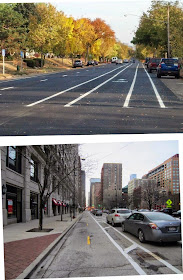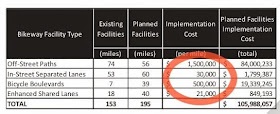 |
| [A cheap bike lane on Plymouth Avenue in Minneapolis.] |
(Note that "pushing Saint Paul into the bicycling future" is kind of like going up the High Bridge on a wrongly-geared single speed.)
The plan is good, though, and full of maps showing bike infrastructure on many (but not most) of the city's most crucial streets. Plus it has an exciting plan for a "downtown loop" that tie Saint Paul together and connect downtown's many individualized attractions into a coherent network of "8-80" accessible places. The sun may finally be setting on Saint Paul's great blank wall era.
The Plan's Functional Classifications
Like most such plans, Saint Paul's bike plan offers a bunch of different solutions to providing bike infrastructure that depend both on the spatial context and the type of bike riding being accommodated.
 |
| [Part of the bike plan.] |
1) Enhanced shared lanes -- basically sharrows, but as nice as sharrows can be. To my mind, these can be useful in places with extremely low traffic volume and slow speeds. (For example, the westernmost section of Montreal Avenue.)
2) Bicycle Boulevards -- I've written about these before. The city here describes them thus:
Open and usable by motorists, and .. do not impact on-street parking. However, longer motorized trips on bicycle boulevards are discouraged, providing a lower-speed, traffic-calmed environment where longer-distance trips by bicycle are more attractive.
There are many ways to water boulevards down and make them almost purely symbolic. (See the TCSidewalks half-ass prize for design mediocrity). But generally bike boulevards are great way to create a bicycle network on neighborhood streets. Despite what the Germans would have you believe, they are an amenity to their neighborhoods because they slow traffic down, you can plant flowers on them, and if designed well, they provide comfortable safe space for people of all ages to ride around the city.
3) In-Street separated lane -- The whole gamut of bike lanes, from narrow crappy ones to buffered/separated cycletrack-style. There's a lot of room in here...
4) Off-street path -- Basically, anything that is separated completely from the road right of way. Often in Saint Paul this means a park-like sidepath (e.g. the Mississippi River Road), but could also refer to something like the Midtown Greenway or the proposed downtown bike loop.
As a whole, the future Saint Paul bicycle network will feature all of these different types of routes, which makes sense given the wide variety of bicyclists that actually exist in the city. You need some things for some people (e.g. fast bike lane-type roads for speedy commuters) and other things for other people (e.g. comfortable leisurely routes for more relaxed cruisers and/or families).
 |
| [Map of the proposed bike network.] |
At Last, the Point: Some Things are Cheap
At least that's what would happen in a perfect world... In the real world of actual cities with actual overworked employees and budget shortfalls, implementing a bicycle plan involves making difficult choices. Probably the biggest limitation is money. The way the system is currently set up in Saint Paul, paying for new bicycle infrastructure usually involves taking money away from rec centers, libraries, or fire fighters.
(Of course it doesn't have to be that way; compared to road infrastructure, bicycle projects are cost effective, especially if you account for externalities like public health or local economic investment.)
When it finally begins discussing the city's fiscal realities, the implementation section of the Saint Paul Bike Plan includes a chart that outlines the rather astonishing theoretical costs of the complete plan's build out:
While the eye-popping $105 million figure seems daunting, there are a few reasons why this estimate is really an extreme exaggeration. The first is that many bike projects can be done for almost zero cost when included within already planned street projects. (For example, the Riverside Avenue bike lanes in Minneapolis or the Jackson Street leg of the downtown bike loop are both part of already existing street reconstructions.) If the city were to gradually build the bike network as part of its regular maintenance, in a just a few short decades the plan could be completed almost "for free."
(Caveat: unless you were born after 1985, you'll likely be dead. Of course, I plan to die in a horrible "accident" where I'm run over by an SUV, which may or may not be driven by Soucheray himself, by the Town and Country Golf Course next to the Marshall Avenue bridge...)
The second is what I mentioned before: investing in bicycles has economic benefits for cities like Saint Paul that offsets many bike infrastructure costs. For example, the Charles Avenue bike boulevard also dramatically improves safety in the Frogtown neighborhood, slowing traffic along 4-lane "death road"-style arterials, for example. Bicyclists are more likely to stop and spend more money at local businesses (rather than big box stores). Bicycling and walking is one of the cheapest and most effective ways to improve public health. Shifting mode share toward bicycling decreases local pollution effects such as asthma, etc. etc.
Finally, the Point
But the most interesting thing about the above chart is the disparity in costs-per-mile between bicycle infrastructure types. Look again at the chart, particularly the per-mile costs:
While off-street separated lanes (parkstyle sidepaths) are expensive, on-street separated lanes are very cheap. For example, Hennepin county's successful re-striping of Park and Portland Avenues in central south Minneapolis was a very cheap project.
It's amazing that on-street cycletrack projects, which are also the gold standard of new bicycle designs, are so inexpensive. The only thing they require is paint and political will and maybe a plastic bollard or two, and for that small sum you get many of the safety, economic, and public health benefits of bicycling for pennies on the dollar. A city like Saint Paul could implement ten times as many cycletrack-style treatments on its arterial roads for the cost of a few fancy sidepaths,
This isn't to say that we shouldn't spend money on high quality bike improvements; especially during street reconstructions, they are great investments. Rather, it's a pleasant surprise that, in an era when accountability and fiscal responsibility are buzzwords on both the left and right, the best kind of bike infrastructure is also the cheapest.
 |
| [Minneapolis' Park Avenue on the top; Chicago's Dearborn Street on the bottom.] |



No comments:
Post a Comment